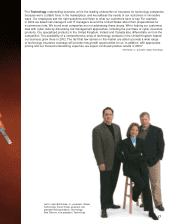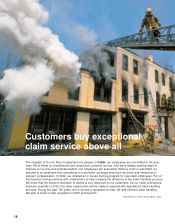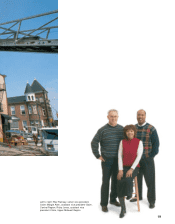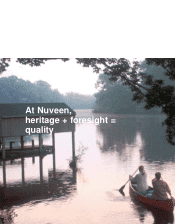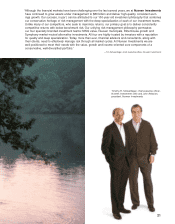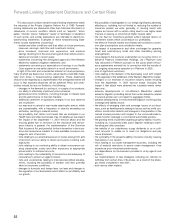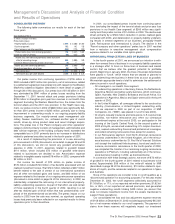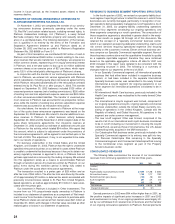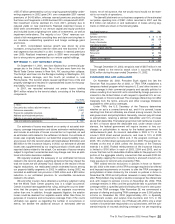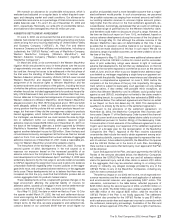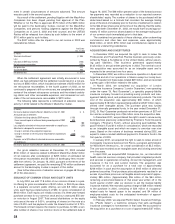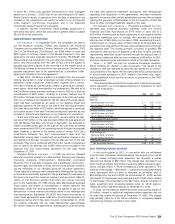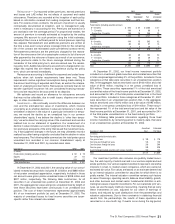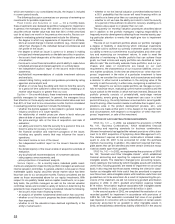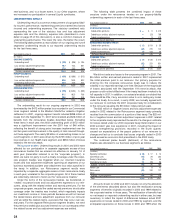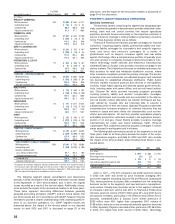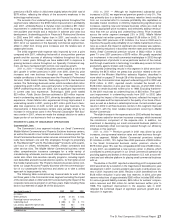Travelers 2002 Annual Report Download - page 29
Download and view the complete annual report
Please find page 29 of the 2002 Travelers annual report below. You can navigate through the pages in the report by either clicking on the pages listed below, or by using the keyword search tool below to find specific information within the annual report.
We maintain an allowance for uncollectible reinsurance, which is
evaluated and adjusted on a regular basis to reflect disputed cover-
ages and changing market and credit conditions. Our allowance for
uncollectible reinsurance as a percentage of total reinsurance recov-
erable balances was 1.5% and 1.6% as of December 31, 2002 and
2001, respectively. Historically, our write-offs of uncollectible reinsur-
ance balances have averaged less than $3 million per year.
ASBESTOS SETTLEMENT AGREEMENT
On June 3, 2002, we announced that we and certain of our sub-
sidiaries had entered into an agreement settling all existing and future
claims arising from any insuring relationship of United States Fidelity
and Guaranty Company (“USF&G”), St. Paul Fire and Marine
Insurance Company and their affiliates and subsidiaries, including us
(collectively, the “USF&G Parties”) with any of MacArthur Company,
Western MacArthur Company (“Western MacArthur”), and
Western Asbestos Company (“Western Asbestos”) (together, the
“MacArthur Companies”).
On March 26, 2002, a trial commenced in the Western MacArthur
litigation which was planned to occur in three phases over the course
of approximately one year and which involved complex questions of
fact and law. Among the issues to be addressed in the first phase of
the trial were the standing of Western MacArthur to recover under
Western Asbestos’ policies issued by USF&G (USF&G never insured
Western MacArthur and disputed Western Asbestos’ purported
assignment of its insurance rights to Western MacArthur) and the
existence and terms and conditions of the policies, including the issue
of whether the policies contained products hazard coverage and, if so,
whether the policies included aggregate limits for products hazard lia-
bility.USF&G believed it had, and continues to believe that it has, mer-
itorious defenses to the purported assignments of insurance rights by
Western Asbestos to Western MacArthur, which Western MacArthur
alleged occurred in the 1967-1970 time period and in 1997 and which
were allegedly ratified in 1999. USF&G also believed that it had a
strong position that the policies did not contain products hazard cov-
erage, but that even if they did the coverage was subject to products
hazard aggregates, which limited the USF&G Parties’ exposure. As
the trial began, we believed that we could resolve the case by litiga-
tion or settlement within our existing asbestos reserves (gross
asbestos reserves totaled $478 million as of December 31, 2001) on
the basis of the foregoing defenses, a belief supported by Western
MacArthur’s November 1999 settlement of a similar claim brought
against another defendant insurer for $26 million. Given the facts and
circumstances known by management at the time we filed our annual
report on Form 10-K, we believed that our best estimate of aggregate
asbestos reserves as of December 31, 2001 made a reasonable pro-
vision for Western MacArthur and all other asbestos claims.
The first phase of the trial began on March 26, 2002. During the
second quarter of 2002, developments in the trial caused us to
reassess our exposure based on the increased possibility of an
adverse outcome in the first phase of the litigation. Among the signif-
icant developments in the trial between April 1 and May 15, 2002 were
evidentiary decisions by the trial judge to exclude evidence favorable
to USF&G regarding the assignment issue and to allow into evidence
unfavorable evidence regarding other insurers’ policies on the aggre-
gate limits issue, and unexpected adverse testimony on the aggregate
limits issue. These developments led us to believe that there was an
increased risk that the jury could find that USF&G’s policies did not
contain aggregate limits for products hazard claims.
These developments at trial, coupled with general changes in the
legal environment affecting the potential liability of insurers for
asbestos claims, caused us to engage in more intense settlement dis-
cussions at the end of April, in May, and early June of 2002.
As of May 15, 2002, the date on which we filed our Form 10-Q for
the quarter ended March 31, 2002, the trial and settlement discus-
sions were ongoing, but the parties to the settlement discussions had
been unable to reach agreement on structure, amount and other sig-
nificant terms. At that time, we were prepared to end settlement dis-
cussions based on our continued belief that we could litigate our
position and possibly reach a more favorable outcome than a negoti-
ated settlement would provide. In such circumstances, we perceived
the possible outcomes as ranging from minimal amounts well within
our existing asbestos reserves to unknown higher amounts (poten-
tially higher than the amount in the final settlement agreement, dis-
cussed below). Accordingly, we believed that we could not estimate a
reasonable range of potential loss for the Western MacArthur claim,
and therefore could make no disclosure of such a range. However, at
the time we filed such report on Form 10-Q, we believed, based on
various adverse developments during the course of the first phase of
the trial through May 15, that although the ultimate outcome of the
Western MacArthur case was not determinable at that time, it was
possible that its resolution could be material to our results of opera-
tions and we made disclosure of this fact in such report. We did not
disclose a range of possible outcomes, as we were unable to do so at
the time of the filing.
Subsequent to May 15, 2002, there were additional adverse devel-
opments at the trial. USF&G’s motions for nonsuit and for reconsider-
ation of prior evidentiary rulings were denied. In light of continued
adverse trial developments, the fact that jury deliberations on this first
phase of the trial were expected to commence as soon as the second
week of June, and in an effort to put our largest known asbestos expo-
sure behind us, we began negotiating a single lump-sum payment set-
tlement with the plaintiffs. Negotiations were intense and ultimately we
achieved a comprehensive agreement on June 3, 2002, before the
completion of the first phase of the jury trial. Importantly, this agree-
ment (which is subject to bankruptcy court approval) not only settled
pending claims, it also settled, with possible minor exceptions, all
claims that Western MacArthur and its affiliates could possibly have
against us and USF&G, including but not limited to the claims made in
the pending lawsuit, for a pretax liability then estimated at $988 million
as described below. The settlement agreement was filed as an exhibit
to our Report on Form 8-K dated July 23, 2002. This description is
qualified in its entirety by the terms of the settlement agreement.
Pursuant to the provisions of the settlement agreement, on
November 22, 2002, the MacArthur Companies filed voluntary peti-
tions under Chapter 11 of the Bankruptcy Code to permit the channel-
ing of all current and future asbestos-related claims solely to a trust to
be established pursuant to Section 524(g) of the Bankruptcy Code.
Consummation of most elements of the settlement agreement is con-
tingent upon bankruptcy court approval of the settlement agreement
as part of a broader plan for the reorganization of the MacArthur
Companies (the “Plan”). Approval of the Plan involves substantial
uncertainties that include the need to obtain agreement among exist-
ing asbestos plaintiffs, a person to be appointed to represent the inter-
ests of unknown, future asbestos plaintiffs, the MacArthur Companies
and the USF&G Parties as to the terms of such Plan. Accordingly,
there can be no assurance that bankruptcy court approval of the Plan
will be obtained.
Upon final approval of the Plan, and upon payment by the USF&G
Parties of the amounts described below, the MacArthur Companies
will release the USF&G Parties from any and all asbestos-related
claims for personal injury, and all other claims in excess of $1 million
in the aggregate, that may be asserted relating to or arising from
directly or indirectly, any alleged coverage provided by any of the
USF&G Parties to any of the MacArthur Companies, including any
claim for extra contractual relief.
The after-tax impact on our 2002 net income, net of expected rein-
surance recoveries and the re-evaluation and application of asbestos
and environmental reserves, was approximately $307 million. This
calculation, summarized in the table below, reflected payments of
$235 million during the second quarter of 2002, and $740 million on
January 16, 2003. The $740 million (plus interest) payment, together
with $60 million of the original $235 million, shall be returned to
USF&G Parties if the Plan is not finally approved. The settlement
agreement also provided for the USF&G Parties to pay $13 million
and to advance certain fees and expenses incurred in connection with
the settlement, bankruptcy proceedings, finalization of the Plan and
efforts to achieve approval of the Plan, subject to a right of reimburse-
The St. Paul Companies 2002 Annual Report 27


